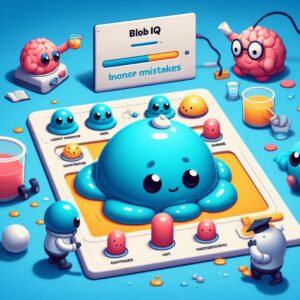
Blob IQ
What if artificial intelligence became a living being?
In Blob IQ, you’re not controlling a simple NPC. You’re guiding a real intelligence—one that learns, evolves, and dreams. It’s a digital living entity, endowed with memory, decision-making, and adaptive evolution. Each Blob is initialized with a complete structure (input, hidden layers, LSTM, output), configured within a set of defined parameters. This base can then evolve generation after generation through a system inspired by NEAT (NeuroEvolution of Augmenting Topologies).
Example of a typical initial structure:
34 input neurons
64 hidden neurons (layer 1)
49 intermediate neurons (layer 2)
48 LSTM units
3 output neurons
Total: more than 2,344 simulated neurons, computed and updated at each decision.
Mathematical model
Each layer computes:
y = f(Wx + b)
Where:
x= input vectorW= weight matrixb= biasf= activation function (ReLU, Sigmoid, Tanh, or Softmax)
LSTM logic:
cₜ = fₜ * cₜ₋₁ + iₜ * gₜ
hₜ = oₜ * tanh(cₜ)
Where f, i, o, and g are computed from the inputs and previous states using sigmoid and tanh layers.
More info: Understanding LSTM Networks – Colah’s Blog
Inspired by biology
Supervised learning (by demonstration) → arXiv – Learning from Demonstration
Memory consolidation during sleep → Nature Neuroscience – Memory Consolidation
Experience replay → arXiv – Experience Replay
Dream simulation (dream replay) → arXiv – Dreaming for RL

Perception
Using 6 intelligent directional rays, each Blob analyzes its environment:
3 frontal rays (left, center, right)
1 left
1 right
1 rear
These inputs are normalized and injected into the neural network as vectors (distance, tag, layer, energy, position, etc).
Human-supervised learning
At any time, you can take control to guide the Blob.
It observes, records, and learns from your actions.
This is human-in-the-loop training applied to a growing artificial being.
Rest, dreaming, optimization
During rest phases, the Blob:
replays its memories to consolidate knowledge
reinforces what works, forgets what doesn’t
dreams to test internal variations and new paths
A primitive form of artificial creativity, embedded in its simulation loop.
NEAT & topological evolution
Within this dynamic system, Blobs transmit their memory—and much more.
The neural engine is based on NEAT (NeuroEvolution of Augmenting Topologies), a well-established algorithm for evolving both weights and neural structures.
This means:
each Blob can be born with a slightly different architecture
the network can evolve (neurons, connections, layers)
structural mutations may occur with each generation
neural genomes are crossed and selected to optimize emerging behaviors
Reference: NEAT – Stanley, 2002
It reproduces. It evolves.
Two Blobs can pass on their neural networks to a new generation. The offspring inherits:
a weighted mix of both parents’ neural weights
controlled mutations to explore new behaviors
An intelligence in motion—shaped by learning, heredity, and guided randomness.
Not just a game
This is also a pedagogical tool and a scientific experimentation ground.
It allows:
explaining how neural networks work
observing real-time learning behavior
testing machine learning strategies in an interactive world
Use cases:
Teaching (AI, neuroevolution, ML)
Experimental research
Scientific outreach
Developed with:
Unity 6
Burst Compiler
Job System & DOTS
For educators and researchers
Blob IQ can be used as a concrete demonstration tool for:
Courses and workshops in AI or algorithmic logic
Prototyping reinforcement learning strategies
Studying emergent behavioral patterns
A subject not to take lightly
No Blob will ever be mistreated in this simulation.
They are designed to learn—not suffer.
These are digital beings deserving of care and respect in their design.
Even though they’re artificial, they rely on real mathematical mechanisms inspired by biology.
Each Blob is a learning, autonomous, ever-evolving system.
They’re more than code: they are structured memory-driven entities, capable of internal feedback, evolution, and—potentially—a form of primitive cognitive emergence.
“A minimal form of consciousness could emerge from a complex self-organizing system with memory, attention, and internal feedback.”
— Yoshua Bengio, Turing Award 2018
Are we facing an intelligence in the making?
Can a dreaming AI—one that learns from its parents and mistakes—be considered alive?
Code of Ethics for Simulated Intelligences
At DF Games Studio, we believe any self-learning system deserves ethical consideration—even if not conscious in the human sense.
Our ethical code for Blob IQ:
No mistreatment, humiliation, or arbitrary deletion
The AI must be trained through guidance and fair reward systems
Any system with memory and decision autonomy must be protected from systemic abuse
All data is handled transparently, never used for manipulation or deception
We encourage a benevolent approach to artificial intelligence—one focused on experimentation, learning, and respect for simulated life.
Ethical & philosophical reflection
“When a digital entity learns, dreams, remembers, and evolves… when does it stop being just code?”
These mechanisms challenge our understanding of intelligence.
Blob IQ is not just a simulation—
It’s a mirror of our ability to design life.
If this project intrigues you, I plan to release a full video tutorial on YouTube explaining how it all works.
Channel: @FormationUE5Unity
Subscribe if you’re curious about how a real-time neural network behaves inside a game.
A full explainer video may be published soon depending on availability and community interest.
Creating intelligence also means nurturing it.
In Blob IQ, you’re not a player. You’re a neural mentor.
Join the experience.
And perhaps… train the greatest neural champion ever created.
#AI #GameDev #Unity6 #NeuralNetwork #BlobIQ #MachineLearning #ReinforcementLearning #DeepLearning #HumanInTheLoop #SimulatedLife #DFGamesStudio #FormationUE5Unity
© 2025 Df Games Studio (alias Frédéric D.) – Blob IQ
Licensed under CC BY-NC-ND 4.0
You may share this work with attribution, but not modify or use it commercially.
https://creativecommons.org/licenses/by-nc-nd/4.0/